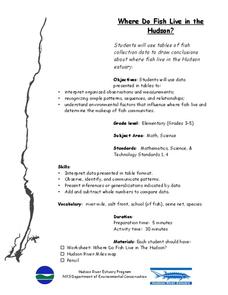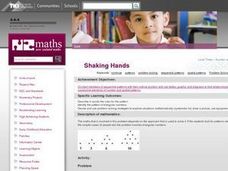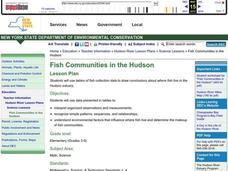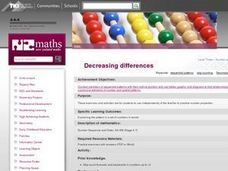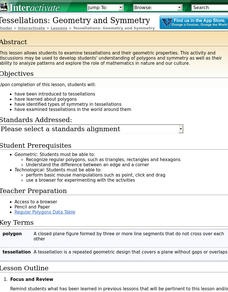Curated OER
Get a Leg Up
Traveling through space is an amazing experience, but it definitely takes a toll on the body. After reading an article and watching a brief video, learners perform an experiment that simulates the effects of zero gravity on the human body.
Curated OER
Counting By 5s
Second graders count by 5's to 100. In this math instructional activity conducted on the 100th day of school, 2nd graders use picture stamps in the KidPix program to count by 5's and get to 100.
Curated OER
Reno's Dilemma
Students explain proportions as it relates to principle and interest. They use proportions to explain relationships and analyze relationships by identifying patterns.
Curated OER
Where Do Fish Live in the Hudson?
Learners explore the environmental factors that influence where fish live and determine the makeup of fish communities in the Hudson. They interpret guided observations and measurements to assess patterns, sequences and relationships.
Curated OER
Irregular Fractals
Students study and research irregular fractals and construct a few based on their research. Students practice pattern recognition skills and plane geometry skills calculating dimensions on the Fractured Pictures activity.
Curated OER
Motion Capture and Analysis
Students investigate the concepts and relationships of speed, displacement and time. They capture the serve motion of a tennis player via video or digital camera and analyze the speed of the ball and racquet head.
Curated OER
Pyrotechnics
Students discuss pyrotechnics and what they have noticed about their height and speed. They think about the path which fireworks follow which is a parabola. They follow multiplication patterns to determine the Zero Product Property and...
Curated OER
Supermarket Displays
Second graders look at the number patterns created when cans are stacked in different arrangements. The aim of the unit is for students to keep track of the numbers involved by drawing up a table of values. They are then encouraged to...
Curated OER
Shaking Hands
Pupils use diagrams or lists to show relationships. They also identify the pattern of triangular numbers. The mathematics behind situations provide a way of problem solving to examine the answers.
Curated OER
Sonic Booms and Logarithms
Young scholars practice working with the symbolic notation for logarithms. They understand various types of patterns and functional relationships. They use symbolic forms to represent and analyze mathematical situations.
Curated OER
Fish Communities in the Hudson
Students use tables of fish collection data to draw conclusions about where fish live in the Hudson Estuary. Given available data they interpret organized observations and measurements and recognize simple patterns, sequences, and...
Curated OER
Decreasing Differences
Students identify and interpret the pattern within a set of numbers using words. Then they write rules in words using complete sentences. Students also highlight two similar sequences with the same difference in order to get the first...
Curated OER
Chessboard Challenge
Second graders read "The King's Chessboard" by David Birch. The teacher reads the story aloud and pauses at several points for students to calculate the next number in a pattern of doubling.
Curated OER
The Truth About Triangles and Squares
Fourth graders investigate the patterns associated with both triangular and square numbers. They use counters as manipulatives to depict the numbers as needed but focus on problem solving using mental math techniques.
Curated OER
Rows of Numbers
Students generate patterns from a structured situation, find a rule for the general term, and express it in words and symbols. They also devise and use problem solving strategies in a systematic way.
Curated OER
Toothpick squares
Students state the general rule for a practical situation. They describe a continuing pattern. They use toothpicks to help visualize the problem and answer it correctly.
Curated OER
Tessellation Quilt Squares
Fifth graders design a "quilt block" that has a tessellating pattern to help create a class tessellation quilt. They describe relationships between two- and three-dimensional shapes and analyze attributes and properties of geometric...
Curated OER
Fractions of a Set
Third graders use fractions to describe part of a set. In this fractions lesson, 3rd graders are introduced to fractions through a book and use pattern blocks to describe a fraction as a part of a set. This lesson includes a scripted...
Curated OER
Bubblegum balls
Learners look for patterns to solve problems involving statistics using different colored gumballs. They should be able to look for and find out all the possible outcomes based upon inference and trials.
Curated OER
Can Stack
Learners are able to find the rule for summing consecutive numbers;
identify the pattern of triangular numbers. They then solve the given problem using logic and mathematical reasoning.
Curated OER
Understanding Fractions
Students add and subtract fractions and multiply and divide fractions using pattern blocks.
Curated OER
Geometry and Symmetry
Students examine tessellations and their geometric properties. The lesson plan and discussions may be used to develop students' understanding of polygons and symmetry as well as their ability to analyze patterns.
Curated OER
Rolling For Value
Young scholars participate in a lesson to comprehend the concept of probability while rolling dice. They recognize patterns while making observations and recording the data for each roll. Students also review place values while playing a...
Curated OER
Locating the Salt Front
Learners use Hudson River salinity data to create a line
graph that shows the location of the salt front, and use math
skills to explore how this location varies over time. They use the graph to estimate the location of the salt front...





